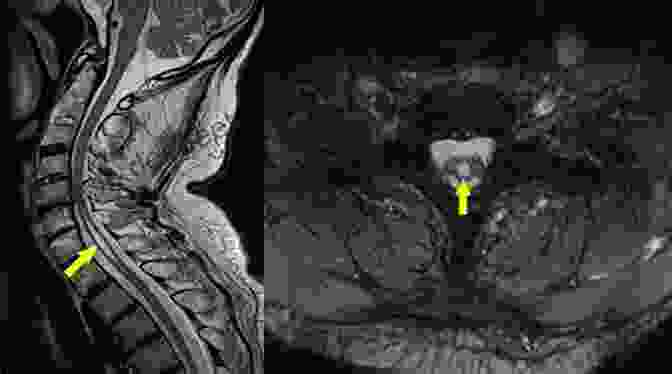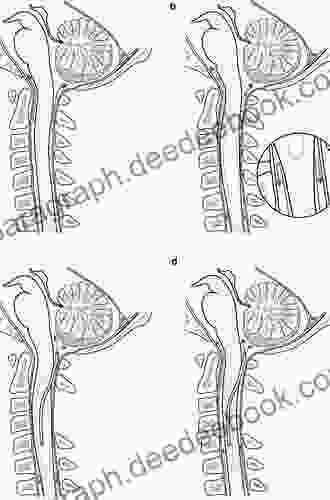Syringomyelia: A Comprehensive Guide to Cerebrospinal Fluid Circulation Disorder


5 out of 5
| Language | : | English |
| File size | : | 10119 KB |
| Text-to-Speech | : | Enabled |
| Enhanced typesetting | : | Enabled |
| X-Ray for textbooks | : | Enabled |
| Print length | : | 887 pages |
| Screen Reader | : | Supported |
Syringomyelia, a condition characterized by the presence of a fluid-filled cavity (syrinx) within the spinal cord, is a complex neurological disorder affecting the flow of cerebrospinal fluid (CSF). CSF is a clear, colorless liquid that surrounds the brain and spinal cord, providing essential nutrients and cushioning. In syringomyelia, the normal circulation of CSF is disrupted, leading to the formation of a syrinx that can cause progressive neurological damage. Understanding this disorder is critical for both patients and healthcare professionals to ensure timely diagnosis and appropriate treatment.
Etiology: Causes of Syringomyelia
The precise cause of syringomyelia is not fully understood, but several underlying factors have been identified:
- Chiari Malformation: The most common cause of syringomyelia is Chiari malformation, a congenital brain condition where the lower part of the cerebellum (the brainstem) extends into the spinal canal. This can obstruct CSF flow and lead to syrinx formation.
- Trauma: Spinal cord injuries can disrupt CSF circulation, causing the accumulation of fluid and the development of a syrinx.
- Infections: Certain infections, such as meningitis and encephalitis, can cause inflammation and scarring of the spinal cord, leading to CSF flow obstruction.
- Tumors: Spinal cord tumors can compress the spinal cord and disrupt CSF flow, contributing to syringomyelia.
- Genetic Factors: While rare, some cases of syringomyelia have been attributed to genetic abnormalities.
Pathophysiology: How Syringomyelia Develops
Syringomyelia results from impaired CSF circulation, which leads to a cascade of events:
- Obstruction of CSF Flow: The underlying cause of syringomyelia obstructs CSF flow within the spinal canal. This can be due to Chiari malformation, trauma, infections, tumors, or other factors.
- Increased Pressure: The obstruction of CSF flow causes an increase in pressure within the spinal canal, leading to stress on the spinal cord tissue.
- Spinal Cord Damage: The increased pressure and altered CSF dynamics can damage the spinal cord tissue, leading to the formation of a fluid-filled cavity (syrinx).
- Progression: Over time, the syrinx can enlarge and extend further along the spinal cord, causing progressive neurological damage.
Signs and Symptoms
The clinical presentation of syringomyelia can vary depending on the location and size of the syrinx. Common symptoms include:
- Pain: Progressive pain in the neck, back, arms, or legs is a hallmark of syringomyelia.
- Weakness: Muscle weakness and atrophy in the arms and legs can occur as the syrinx compresses the spinal cord.
- Sensory Loss: Numbness and loss of sensation, especially in the hands and feet, are common due to damage to sensory nerves.
- Spasticity: Involuntary muscle stiffness and spasms can affect the arms and legs.
- Bowel and Bladder Dysfunction: In severe cases, syringomyelia can impair bowel and bladder control.
- Scoliosis: Abnormal curvature of the spine (scoliosis) can develop as a result of muscle weakness and imbalance.
Diagnosis
An accurate diagnosis of syringomyelia is essential for appropriate treatment. The diagnostic process typically involves:
- Medical History: A thorough medical history can provide clues about potential causes and progression of symptoms.
- Physical Examination: A physical examination helps identify neurological deficits, such as muscle weakness, sensory loss, and abnormal reflexes.
- Magnetic Resonance Imaging (MRI): MRI is the gold standard imaging technique for diagnosing syringomyelia. It provides detailed images of the spinal cord and surrounding structures, allowing visualization of the syrinx.
- Computed Tomography (CT Scan): A CT scan may be used to complement MRI or evaluate bone abnormalities in the spine.
- Electromyography (EMG): EMG measures electrical activity in muscles and nerves to assess nerve function and identify areas of damage.
Treatment
The treatment strategy for syringomyelia depends on the underlying cause, severity of symptoms, and progression of the condition. Treatment options include:
Conservative Management
- Medications: Pain relievers and muscle relaxants can help manage pain and discomfort.
- Physical Therapy: Targeted exercises can improve muscle strength, balance, and mobility.
- Occupational Therapy: Occupational therapy helps patients adapt to functional limitations and learn assistive techniques.
Surgical Intervention
In cases where conservative management is insufficient or the condition worsens, surgical intervention may be necessary:
- Syringosubarachnoid Shunt: This surgical procedure involves creating a pathway for CSF to flow from the syrinx into the subarachnoid space (the space surrounding the brain and spinal cord). The shunt is a small device that maintains the flow of CSF and prevents its accumulation in the spinal cord.
- Endoscopic Third Ventriculostomy (ETV): In cases of Chiari malformation, ETV involves creating an opening in the floor of the third ventricle (a fluid-filled cavity in the brain) to improve CSF circulation and reduce pressure on the spinal cord.
- Posterior Fossa Decompression and Spinal Cord Untethering: This surgical approach involves removing part of the skull (posterior fossa decompression) and releasing any tethering or adhesions that may be compressing the spinal cord.
Prognosis
The prognosis for syringomyelia can vary widely, depending on the underlying cause, severity, and timeliness of treatment. With early diagnosis and appropriate management, many patients can experience stabilization or improvement of their symptoms. However, progressive neurological damage can occur if the condition is left untreated or inadequately managed.
Support and Resources
Navigating a diagnosis of syringomyelia can be challenging, and connecting with support systems and resources can be invaluable:
- Syringomyelia Support Groups: Joining support groups can provide emotional support, information sharing, and a sense of community.
- Online Resources: Websites and forums dedicated to syringomyelia offer reliable information and opportunities to connect with others affected by the condition.
- Medical Professionals: Neurosurgeons, neurologists, and physiatrists specialize in the diagnosis and management of syringomyelia and can provide comprehensive guidance and support.
Syringomyelia is a complex disorder affecting CSF circulation and the spinal cord. Understanding the causes, symptoms, diagnostic techniques, and treatment options is crucial for effective management. By working closely with healthcare professionals and accessing support resources, patients can navigate this condition and strive for the best possible outcomes. Further research is essential to advance our knowledge of syringomyelia, improve treatment strategies, and enhance the quality of life for those affected by this challenging condition.
5 out of 5
| Language | : | English |
| File size | : | 10119 KB |
| Text-to-Speech | : | Enabled |
| Enhanced typesetting | : | Enabled |
| X-Ray for textbooks | : | Enabled |
| Print length | : | 887 pages |
| Screen Reader | : | Supported |
Do you want to contribute by writing guest posts on this blog?
Please contact us and send us a resume of previous articles that you have written.
 Novel
Novel Page
Page Genre
Genre Library
Library Paperback
Paperback E-book
E-book Newspaper
Newspaper Bookmark
Bookmark Shelf
Shelf Glossary
Glossary Foreword
Foreword Preface
Preface Synopsis
Synopsis Scroll
Scroll Bestseller
Bestseller Narrative
Narrative Biography
Biography Autobiography
Autobiography Reference
Reference Encyclopedia
Encyclopedia Thesaurus
Thesaurus Librarian
Librarian Catalog
Catalog Stacks
Stacks Study
Study Scholarly
Scholarly Reserve
Reserve Academic
Academic Journals
Journals Rare Books
Rare Books Special Collections
Special Collections Literacy
Literacy Study Group
Study Group Thesis
Thesis Dissertation
Dissertation Storytelling
Storytelling Reading List
Reading List Book Club
Book Club Theory
Theory Textbooks
Textbooks Noah Child
Noah Child David H Pascoe
David H Pascoe Katherine Slee
Katherine Slee Gundi Gabrielle
Gundi Gabrielle Hendrik Lambertus
Hendrik Lambertus Nick Joaquin
Nick Joaquin The Old Bog Road
The Old Bog Road Mykola Riabchuk
Mykola Riabchuk Peter Magadini
Peter Magadini Julius Hey
Julius Hey Michael Slack
Michael Slack Jupiter Rueda De Leon
Jupiter Rueda De Leon Marco D Eramo
Marco D Eramo Audrey Kurth Cronin
Audrey Kurth Cronin Joan A Medlicott
Joan A Medlicott Michael Mandelbaum
Michael Mandelbaum Kelli Jo Ford
Kelli Jo Ford David M Nienow
David M Nienow H Lynn Erickson
H Lynn Erickson Mark A Radice
Mark A Radice
Light bulbAdvertise smarter! Our strategic ad space ensures maximum exposure. Reserve your spot today!

 Russell MitchellCompletely Gripping Crime Thriller That Will Hook You From Page One: Denning...
Russell MitchellCompletely Gripping Crime Thriller That Will Hook You From Page One: Denning...
 Galen PowellThe White Earth Nation: A Enduring Legacy of Resilience and Sovereignty in...
Galen PowellThe White Earth Nation: A Enduring Legacy of Resilience and Sovereignty in...
 Russell MitchellDiscover the Enchanting Sights of Rattawut Lapcharoensap: An Unforgettable...
Russell MitchellDiscover the Enchanting Sights of Rattawut Lapcharoensap: An Unforgettable... Owen SimmonsFollow ·16.1k
Owen SimmonsFollow ·16.1k Ron BlairFollow ·6.2k
Ron BlairFollow ·6.2k Ernest ClineFollow ·10.3k
Ernest ClineFollow ·10.3k Brent FosterFollow ·17.3k
Brent FosterFollow ·17.3k Arthur C. ClarkeFollow ·5.2k
Arthur C. ClarkeFollow ·5.2k Danny SimmonsFollow ·11.3k
Danny SimmonsFollow ·11.3k Will WardFollow ·10.7k
Will WardFollow ·10.7k Allen GinsbergFollow ·5.8k
Allen GinsbergFollow ·5.8k

 Ricky Bell
Ricky BellThe Marriage: An Absolutely Jaw-Dropping Psychological...
In the realm of...

 Ray Blair
Ray BlairDiscover the Enchanting Charm of Budapest and Its...
Nestled in the heart of...

 Tyrone Powell
Tyrone PowellHuddle: How Women Unlock Their Collective Power
Huddle is a global movement that empowers...

 Grayson Bell
Grayson BellThe Coin Story of the Holocaust: A Symbol of Hope and...
In the depths of the...

 Virginia Woolf
Virginia WoolfFolklore Performance and Identity in Cuzco, Peru: A...
Nestled amidst...

 Dylan Mitchell
Dylan MitchellThe Enduring Love Story of Héloïse and Abélard: A Tale of...
An Intellectual Passion In the heart of...
5 out of 5
| Language | : | English |
| File size | : | 10119 KB |
| Text-to-Speech | : | Enabled |
| Enhanced typesetting | : | Enabled |
| X-Ray for textbooks | : | Enabled |
| Print length | : | 887 pages |
| Screen Reader | : | Supported |






